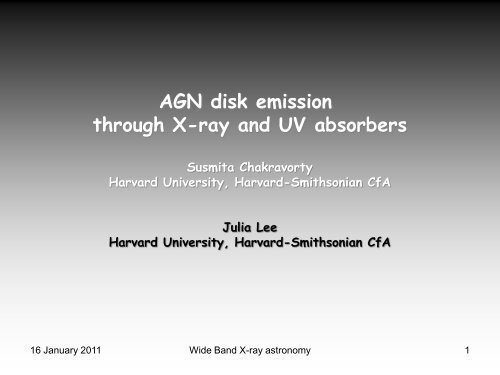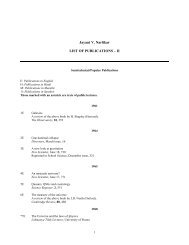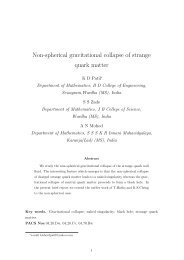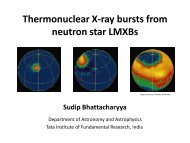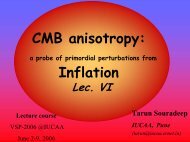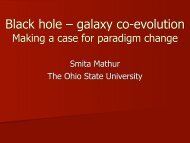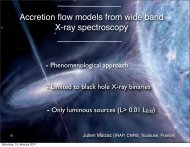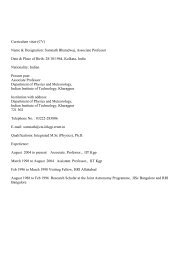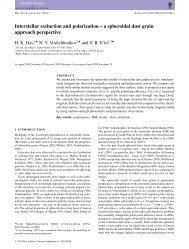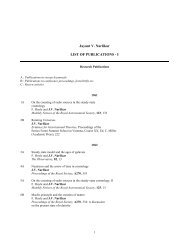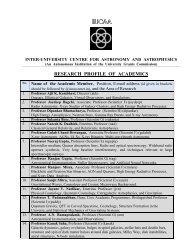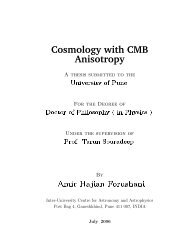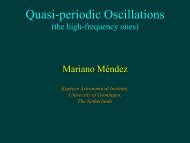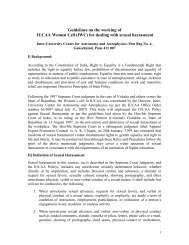AGN disk emission through X-ray and UV absorbers - iucaa
AGN disk emission through X-ray and UV absorbers - iucaa
AGN disk emission through X-ray and UV absorbers - iucaa
Create successful ePaper yourself
Turn your PDF publications into a flip-book with our unique Google optimized e-Paper software.
<strong>AGN</strong> <strong>disk</strong> <strong>emission</strong><strong>through</strong> X-<strong>ray</strong> <strong>and</strong> <strong>UV</strong> <strong>absorbers</strong>Susmita ChakravortyHarvard University, Harvard-Smithsonian CfAJulia LeeHarvard University, Harvard-Smithsonian CfA16 January 2011 Wide B<strong>and</strong> X-<strong>ray</strong> astronomy 1
Background‣ Warm Absorber signatures – 0.3 to 2 keV‣ X-<strong>ray</strong> spectral components of the <strong>AGN</strong> SED• The 1-10 keV powerlaw• The soft excess at ~500 eVSoft ExcessAccretion <strong>disk</strong>componentPower-lawWAAnother significant component<strong>AGN</strong> <strong>disk</strong> at ~ 10 ev16 January 2011 Wide B<strong>and</strong> X-<strong>ray</strong> astronomy 2
Plan of talk‣ Can we decipher the exact shape of the accretion <strong>disk</strong> spectrum?• Use multi-wavelength data for <strong>AGN</strong>.• Can we derive physical parameters like M BH <strong>and</strong> m?‣ Use the <strong>UV</strong> to X-<strong>ray</strong> ionizing continuum• Does it affect the warm absorber?• What are its effect on the <strong>UV</strong> absorber?• Can we draw conclusions on the stability properties of thewarm absorber?• Possible implications for the metallicity of the absorber16 January 2011 Wide B<strong>and</strong> X-<strong>ray</strong> astronomy 3
Constraining M BH <strong>and</strong> m for <strong>AGN</strong>16 January 2011 Wide B<strong>and</strong> X-<strong>ray</strong> astronomy 4
Multi-wavelength SED for <strong>AGN</strong>• Red filled squares areobserved data points.• Near simultaneous X-<strong>ray</strong> <strong>and</strong>Optical data.SpitzerCompositeQSO• Infrared from Spitzer,2MASS <strong>and</strong> IRAS.IRAS2MASSHETCh<strong>and</strong>ra• Green filled squares are`average SED for <strong>AGN</strong>’ in <strong>UV</strong>(Telfer et.al. 2002).• The blue lines are arbitrary,simplistic joins between E<strong>UV</strong><strong>and</strong> X-<strong>ray</strong>.16 January 2011 Wide B<strong>and</strong> X-<strong>ray</strong> astronomy 5
Multi-wavelength SED for <strong>AGN</strong>• Red filled squares areobserved data points.• Near simultaneous X-<strong>ray</strong> <strong>and</strong>Optical data.SpitzerCompositeQSO• Infrared from Spitzer,2MASS <strong>and</strong> IRAS.IRAS2MASSHETCh<strong>and</strong>ra• Green filled squares are`average SED for <strong>AGN</strong>’ in <strong>UV</strong>(Telfer et.al. 2002).• The blue lines are arbitrary,simplistic joins between E<strong>UV</strong><strong>and</strong> X-<strong>ray</strong>.• We wish to model the far <strong>UV</strong>part of the SED with “<strong>disk</strong>bb”.16 January 2011 Wide B<strong>and</strong> X-<strong>ray</strong> astronomy 6
Disk Emission in terms of M BH <strong>and</strong> m‣ Disk model - iso-temperature annuli of accreted matter;each annulus radiating as a blackbody (Shakura & Sunyaev 1973)‣ Diskbb in Xspec or Isis (Makishima et.al. 1986)‣ The temperature profileR.has dependance on M BH <strong>and</strong> mAccretion <strong>disk</strong>component‣ T in = T(R in ) is an input in the“<strong>disk</strong>bb” model, where R in is radiusof innermost stable annulusSoft ExcessPower-law‣ The normalisationhas dependence on M BH <strong>through</strong> R in<strong>and</strong> is an input in the “<strong>disk</strong>bb” model.7
Ionizing continuum‣ Accretion <strong>disk</strong> component by“<strong>disk</strong>bb”Accretion <strong>disk</strong>component‣ Soft Excess• Compton reflection of <strong>disk</strong> photons byplasma at 100 eV, modeled by “nthcomp.Soft ExcessPower-law• Blackbody at 100 eV - X-<strong>ray</strong> photonsreflected off the <strong>disk</strong>.‣ Powerlaw‣ Siemiginowska et.al. 1995‣ Vasudevan & Fabian 200916 January 2011 Wide B<strong>and</strong> X-<strong>ray</strong> astronomy 8
Disk Emission in terms of M BH <strong>and</strong> mR16 January 2011 Wide B<strong>and</strong> X-<strong>ray</strong> astronomy9
Disk Emission in terms of M BH <strong>and</strong> m16 January 2011 Wide B<strong>and</strong> X-<strong>ray</strong> astronomy 10
Disk Emission in terms of M BH <strong>and</strong> m16 January 2011 Wide B<strong>and</strong> X-<strong>ray</strong> astronomy 11
Disk Emission in terms of M BH <strong>and</strong> m16 January 2011 Wide B<strong>and</strong> X-<strong>ray</strong> astronomy 12
Ionizing continua16 January 2011 Wide B<strong>and</strong> X-<strong>ray</strong> astronomy 13
Ionizing effect of <strong>disk</strong> on warm absorber16 January 2011 Wide B<strong>and</strong> X-<strong>ray</strong> astronomy 14
Warm AbsorberSignatures‣ Absorption features in the Soft X-<strong>ray</strong> SpectraCV CVI OVII OVIII NeIX NeX MgXI MgXII SiXIII SiXIVC (V & VI) O (V - VIII) Fe (XVII - XXII) Ne (IX & X) Mg (XI & XII)Al (XII & XIII) Si (XIII - XVI) S (XV & XVI)‣ Absorption features are blue shifted relative to optical <strong>emission</strong>lines, indicating outflow.‣ N H ~ 10 22±1 cm -216 January 2011 Wide B<strong>and</strong> X-<strong>ray</strong> astronomy 15
Derived propertiesWarm Absorber‣ Partially ionized gas in our line of sight to <strong>AGN</strong>‣ = L/nR 2 ~ 10 – 1000 erg cm s -1‣ T gas ~ 10 4 K – 10 6.5 K‣ n H ~ 10 9 cm -3 (10 5 - 10 12 )-- Ionization parameter-- Temperature of the gas-- Density of the gas‣ R gas ~ 0.01 – 100 pc-- Distance of the gas from the central engine‣ Mass loss rate is a substantial fraction of the accretion rate, orexceeds it.(Mathur et.al. 1995, 1998, Crenshaw et.al. 1999)‣ The X-<strong>ray</strong> warm absorber could coexists with a <strong>UV</strong> absorberLy NV SiIV CIV16
Effect of accretion <strong>disk</strong> on the warm absorber• The high ionization species of X-<strong>ray</strong> absorberremain unaffected by the presence of <strong>UV</strong> photons.• However, OVII ion fraction under estimated by30% without <strong>UV</strong> part of SED.• For reasonable ion fractions of the <strong>UV</strong> ions, theaccretion <strong>disk</strong> component is necessary.• Demonstrates the need to know the SED in theultraviolet for a complete description of theabsorbing ions.
On the thermodynamic stabilityof the warm absorberTP
On the thermodynamic stabilityof the warm absorberNo <strong>disk</strong>Disk
Multiple phases in pressure equilibriumDiskZ sol9Z sol16 January 2011 Wide B<strong>and</strong> X-<strong>ray</strong> astronomy20
Summary• Careful reconstruction of the accretion <strong>disk</strong> component can give valuableconstraints on the mass <strong>and</strong> accretion rate of the black hole at the centre ofthe <strong>AGN</strong>.• Astrosat may be very helpful in this area in future.• The accretion <strong>disk</strong> has significant effect on warm absorber, especially ionswith IP ≤ 740 eV (OVII).• The <strong>UV</strong> - X-<strong>ray</strong> absorber connection is better explained if the <strong>disk</strong>component is included in the analysis.• Warm absorber becomes thermodynamically more stable with the inclusion ofthe <strong>disk</strong> component• but multiple phases at different temperatures are not in pressureequilibrium• need super-Solar warm absorber for multi-phase.16 January 2011 Wide B<strong>and</strong> X-<strong>ray</strong> astronomy 21


